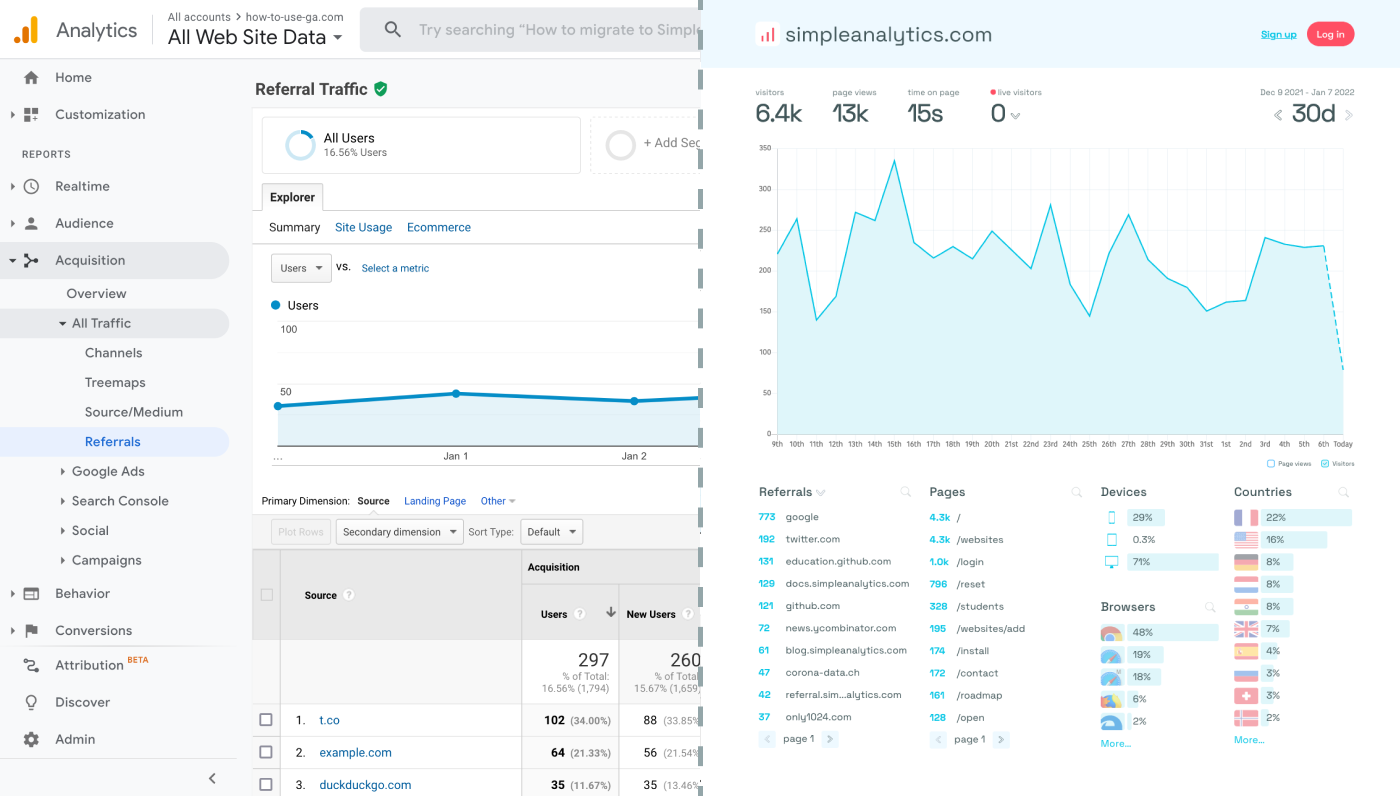While GetResponse offers built-in analytics tools, integrating Google Analytics can hprovide more comprehensive traffic data. This blog will show you how to add Google Analytics to your GetResponse email campaigns, step by step.
Let's dive in!
- Set Up Google Analytics
- Create UTM-Tagged URLs for Your Email Campaigns
- Add UTM-Tagged URLs to Your GetResponse Emails
- Leveraging Insights for Email Marketing Success
- Final Thoughts
Before we dig in I want to show you something. I promise it's worth it...
Google Analytics is great, but also complex and a bit clunky. If you just want a straightforward dashboard with the insights you need, GA is not a great place to start. Additionally, Google doesn't care about privacy and GA requires an annoying cookie banner.
That's why I built Simple Analytics, a privacy-friendly and simple analytics tool - no personal data, no cookies, just the insights you need in a straightforward dashboard.
Here is how it looks vs GA. Feel free to check our live analytics to get an idea for your project. (It is free btw)
All right, enough about us. Now let's get into answering your question!

Set Up Google Analytics
Before integrating Google Analytics with GetResponse, ensure you have a GA account set up for your website. If you're new to Google Analytics, here's how to get started:
- Create a Google Analytics Account: Visit the Google Analytics website and sign in with your Google account. If you don't have one, you'll need to create it.
- Set Up a New Property: Follow the on-screen instructions to create a new GA4 property, choosing "Web" as your platform.
- Obtain Your Measurement ID: After setting up your property, Google will provide you with a Measurement ID (formatted as "G-XXXXXXXXXX"). Note this ID down.
Create UTM-Tagged URLs for Your Email Campaigns
To track the performance of your GetResponse campaigns in Google Analytics, you'll need to create UTM-tagged URLs for each link you plan to include in your emails. Here’s how to do it:
Use a UTM Builder: Utilize an online UTM builder, like the Google Analytics Campaign URL Builder, to generate your URLs. You'll need to input:
- Website URL: The webpage your email will link to.
- Campaign Source: This could be "getresponse" to denote the source of traffic.
- Campaign Medium: Use "email" as the medium.
- Campaign Name: A specific name for your campaign for easy identification in GA.
Generate UTM-Tagged URLs: After filling in the details, the tool will generate a URL with your UTM parameters appended. Use these URLs for links in your GetResponse emails.
Add UTM-Tagged URLs to Your GetResponse Emails
When creating or editing an email within GetResponse:
- Insert Links: Use the UTM-tagged URLs you’ve generated as the links in your email content. This includes text links, buttons, or images directing users to your site.
- Be Consistent: Ensure you use consistent naming conventions for your UTM parameters across different campaigns for accurate tracking and comparison in Google Analytics. We suggest using lowercase characters only to avoid any case-sensitivity issues.
Leveraging Insights for Email Marketing Success
By integrating Google Analytics with your GetResponse email campaigns, you gain access to a wealth of data that can inform your marketing strategies. Analyze which types of content, calls to action, and email designs drive the most website engagement and conversions. Use these insights to refine your future email campaigns, improve your website's user experience, and tailor your marketing efforts to better meet your audience's needs and interests.
Final Thoughts
Adding Google Analytics to your campaign can give you great insights. However, ask yourself: is Google Analytics the right tool for you?
GA is an overpowered solution for straightforward analytics. If you're looking for a simple and intuitive dashboard with the insights you need, there are better alternatives. Yes, I’m talking about my own product (Simple Analytics), but there are others out there as well.
I hated using Google Analytics for my projects. It's clunky, there are hundreds of dashboards and it doesn't look appealing. Also Google doesn't care about privacy or ethics. That's why I decided to build my own and more intuitive web analytics tool.
If this resonates with you, feel free to give Simple Analytics a spin. You just need to add the script and off you go. This takes about one minute- and there is a free version as well!
Enjoy!
